Activity on the Junior Market, remained subdued in Monday,s trading, with only 4 securities being active, resulting in 1,874,825 units valued at $2,598,078 trading. At the close of the Market, the JSE Junior Market Index, increased 0.08 points to close at 666.37 with 2 advancing securities and 2 declining.
 The main trades were, General Accident with 1,212,625 units, while gaining 4 cents to end at $1.62 and Lasco Manufacturing with 642,500 shares to close down by 3 cents, at 95 cents, Lasco Distributors closed up a cent at $1.16 with 10,000 shares and Lasco Financial Services with 9,700 shares, ended at 95 after losing 5 cents.
The main trades were, General Accident with 1,212,625 units, while gaining 4 cents to end at $1.62 and Lasco Manufacturing with 642,500 shares to close down by 3 cents, at 95 cents, Lasco Distributors closed up a cent at $1.16 with 10,000 shares and Lasco Financial Services with 9,700 shares, ended at 95 after losing 5 cents.
At the close, there was 1 stock with the bid higher than the last selling price, and 7 stocks with offers that were lower, in the junior market, 10 stocks had no bids to sell and 5 with no stock on offer, to sell. These are negative indicators.
Only 4 junior market securities trade
Low activity starts week on TTSE
Trading on the Trinidad Stock Exchange saw 8 securities changing hands of which, 3 advanced, 3 declined and 2 traded firm, with 93,942 units changing hands, valued at $888,302.
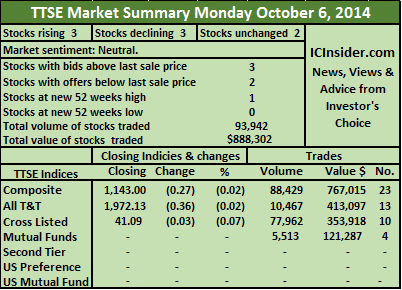 At the close of the market, the Composite Index lost 0.27 points to 1,143.00, the All T&T Index declined 0.36 points to close at 1,972.13 and the Cross Listed Index fell 0.03 points to end at 41.09.
At the close of the market, the Composite Index lost 0.27 points to 1,143.00, the All T&T Index declined 0.36 points to close at 1,972.13 and the Cross Listed Index fell 0.03 points to end at 41.09.
Gains| Stocks increasing in price at the close are, Agostini’s that gained 9 cents, to end at $17.34 after trading 574 shares, while Clico Investment Fund with 5,513 shares valued at $121,287, gained a cent to $22.01 and Unilever Caribbean added 2,000 shares valued at $128,175, the price rose 4 cents to $64.09, for a new 52 weeks’ high.
Declines| The stocks declining at the end of trading are, National Enterprises, traded 200 shares at $17.64, after losing a cent, Sagicor Financial Corporation with 52,962 shares changing hands for a value of $328,918, closed 3 cents down, at $6.23 and Trinidad Cement suffered a 5 cents fall, to close at $2.14, while trading only 268 units.
Firm Trades| Stocks closing with prices unchanged, at the end of trading are, First Citizens Bank which contributed 7,425 shares with a value of $270,867, to close at $36.50 and National Commercial Bank with 25,000 shares traded at $1.
IC bid-offer Indicator| At the end of trading the Investor’s Choice bid-offer indicator had 3 stocks with the bid higher than their last selling prices and 2 stocks with offers that were lower.
More JSE securities trade but less stocks
The number of securities trading Friday, on the Jamaica Stock Exchange, climbed to 22, up from 17 on Thursday and 13 on Wednesday. Price movements were confined to just 9 stocks, with the prices of 4 rising and 5 declining. A total of only 709,978 units traded, valued at $9,562,974, In all market segments.
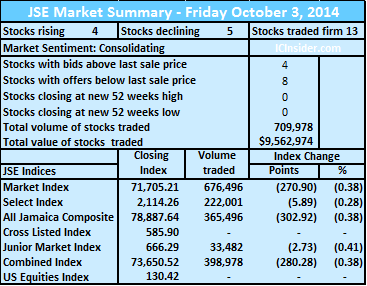 IC bid-offer Indicator| At the end of trading in the main and junior markets, the Investor’s Choice bid-offer indicator showed only 4 stocks with bids higher than their last selling prices and 8 with offers that were lower, which is a slight improvement over Thursday, with 5 to 10, but a continuing negative indicator for the markets, for the current time.
IC bid-offer Indicator| At the end of trading in the main and junior markets, the Investor’s Choice bid-offer indicator showed only 4 stocks with bids higher than their last selling prices and 8 with offers that were lower, which is a slight improvement over Thursday, with 5 to 10, but a continuing negative indicator for the markets, for the current time.
Main Market| The JSE Market Index fell 270.90 points to 71,705.21 and the JSE All Jamaican Composite index declined 302.92 points, to close at 78,887.64.
Gains| Stocks gaining with last traded prices, at the close of the main market are, Grace Kennedy with 109,905 shares, rising 80 cents to $59, National Commercial Bank 50,200 shares changing hands, gained 14 cents to $17.94 and Sagicor Real Estate Fund, closed 10 cents higher at $6.60, with 10,000 units.
Firm| The stocks in the main market to close without a change in the last traded prices are, Cable & Wireless exchanging 20,000 units to close at 29 cents, Jamaica Broilers with only 2,000 shares, closed at $4, Jamaica Money Market Brokers having 29,193 ordinary shares trading to close at $7, Jamaica Producers ended with 9,751 units at $15.50, Mayberry Investments closed with 4,080 shares at $1.50, followed by Radio Jamaica, 11,000 units trading at $1.04 and Seprod having 2,080 shares at $10.90.
Declines| The last traded prices of stocks with losses at the end of trading in the main market are, Carreras in trading just 154 shares lost 3 cents to end at $34.60, Kingston Wharves closed with 38,664 units, after losing 50 cents to end at $5, Sagicor Group 72,000 units led to a 15 cents fall to $9.50 and Scotia Group 6,469 units closed 3 cents lower at $19.02.
Preference| Jamaica Money Market Brokers 8.75% preference share traded 10,000 units at $3.02 and their 7.50% preference share contributed 301,000 units at $2.
A big NCB sell off of US dollars
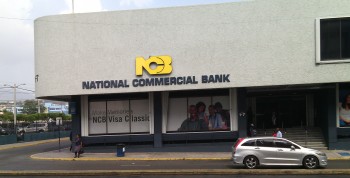 Jamaica’s National Commercial Bank bought US$4,366,621, at an average rate of J$112.31 to the USA dollar, on Friday, but sold US$17,178,604 at an average of J$112.66, the second time within a week, that the country’s dominant bank, was featuring heavily in the market. Last week Friday, National Commercial Bank bought US$20,408,481, at an average rate of $112.70 and sold only US$8,911,292 at $112.75. On Monday, this week Firstcaribbean Bank had a net sell off of US$6 million. The net sales come at a time when the beleaguered Jamaican dollar has been making slow gains, against the US dollar, having peaked at $112.87, on July 25.
Jamaica’s National Commercial Bank bought US$4,366,621, at an average rate of J$112.31 to the USA dollar, on Friday, but sold US$17,178,604 at an average of J$112.66, the second time within a week, that the country’s dominant bank, was featuring heavily in the market. Last week Friday, National Commercial Bank bought US$20,408,481, at an average rate of $112.70 and sold only US$8,911,292 at $112.75. On Monday, this week Firstcaribbean Bank had a net sell off of US$6 million. The net sales come at a time when the beleaguered Jamaican dollar has been making slow gains, against the US dollar, having peaked at $112.87, on July 25.
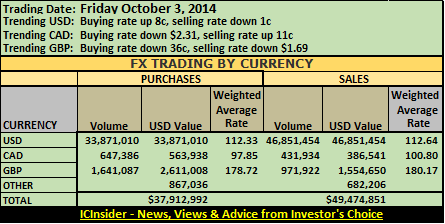 In Friday’s forex trading, outflows exceeded inflows by nearly US$12 million. Authorized dealers purchased the equivalent of US$37,912,992 versus US$26,488,326 on Thursday, the equivalent of US$49,474,851 was sold compared with US$26,902,239 on Thursday.
In Friday’s forex trading, outflows exceeded inflows by nearly US$12 million. Authorized dealers purchased the equivalent of US$37,912,992 versus US$26,488,326 on Thursday, the equivalent of US$49,474,851 was sold compared with US$26,902,239 on Thursday.
In US dollar trading, dealers bought US$33,871,010 compared to US$22,597,931 on Thursday. The buying rate for the US dollar climbed 8 cents to $112.33 and US$46,851,454 was sold versus US$24,072,019 on Thursday, the selling rate inched down 1 cent to $112.64. The Canadian dollar buying rate, dropped $2.31 to $97.85 with dealers buying C$647,386 and selling C$431,934 at an average selling rate that rose 11 cents, to $100.80. The rate for buying the British Pound dropped 36 cents to $178.72, for the purchase of £1,641,087, while £971,922 was sold, at $180.17, down $1.69. Other currencies bought, amounted to the equivalent of US$867,036, while selling was for the equivalent of US$682,206.
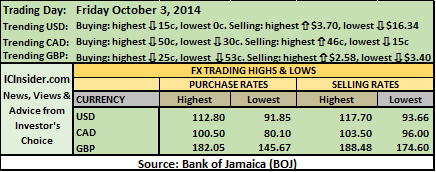 Highs & Lows| The highest buying rate for the US dollar, closed with a loss of 15 cents at $112.80, the lowest buying rate was unchanged at $91.85, the highest selling rate rose $3.70 to $117.70 and the lowest selling rate fell back $16.34 to $93.66. The highest buying rate for the Canadian dollar fell 50 cents to $100.50, the lowest buying rate rose 30 cents to $80.10, the highest selling rate increased 46 cents to $103.50. The lowest selling rate dropped 15 cents to $96. The highest buying rate for the British Pound, dropped 25 cents to $182.05, the lowest buying rate fell 53 cents to $145.67. The highest selling rate jumped $2.58 to $188.48 and the lowest selling rate eased $3.40 to $174.60.
Highs & Lows| The highest buying rate for the US dollar, closed with a loss of 15 cents at $112.80, the lowest buying rate was unchanged at $91.85, the highest selling rate rose $3.70 to $117.70 and the lowest selling rate fell back $16.34 to $93.66. The highest buying rate for the Canadian dollar fell 50 cents to $100.50, the lowest buying rate rose 30 cents to $80.10, the highest selling rate increased 46 cents to $103.50. The lowest selling rate dropped 15 cents to $96. The highest buying rate for the British Pound, dropped 25 cents to $182.05, the lowest buying rate fell 53 cents to $145.67. The highest selling rate jumped $2.58 to $188.48 and the lowest selling rate eased $3.40 to $174.60.
Junior market participation picks up but…
 The number of securities trading in the Junior Market, picked up today to 6, from very low levels previously, but with very low volume. At the close of trading, the price of 1 stock advanced and 1 declined, with a total volume trading was 30,562 units. The JSE Junior Market Index fell 2.73 points to close at 666.29.
The number of securities trading in the Junior Market, picked up today to 6, from very low levels previously, but with very low volume. At the close of trading, the price of 1 stock advanced and 1 declined, with a total volume trading was 30,562 units. The JSE Junior Market Index fell 2.73 points to close at 666.29.
At the close the market there only moderate interest in junior market stocks with no bids to buy 10 stocks and no offer to sell 7 out of the 24 listings in this market segment. There was only one stock with the bid that was higher than the last selling price but 4 stocks had offers that were lower.
Gains| Caribbean Cream the sole stock to gain in the junior market, traded 5,000 with a gain of 5 cents, to close at 70 cents.
Firm Trades| Stocks in the junior market that traded to close at the same price as the day before are, Dolphin Cove with 200 shares at $8, Lasco Distributors traded 2,300 units at $1.15 Lasco Financial 1,500 shares at $1 and Lasco Manufacturing managed to exchange 3,982 units at $1.
Declines| General Accident with 20,500 shares changing hands lost 1 cent to end at $1.58 is the only stock declining in the junior market at the end of trading.
Scotiabank takes another hit
Scotiabank took another hit, in moderate trading on the Trinidad Stock Exchange on Friday, as the stock hit a new 52 weeks low of $59.50. Investors continued to focus on reduced profit for the year to date, and ignoring the improvement, in the July quarters net profit as well as the strong increased lending in the quarter. 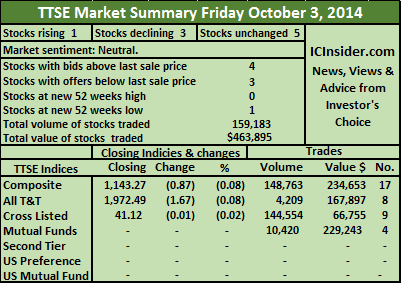
Overall trading saw 9 securities changing hands of which 1 advanced, 3 declined and 5 traded firm with 159,183 units changing hands, with a value of $463,895. The Composite Index lost 0.87 points to close at 1,143.27, the All T&T Index fell by just 1.67 points to close at 1,972.49 and the Cross Listed Index declined by a mere 0.01 points to end at 41.12.
Gains| First Citizens Bank recorded the sole price increase, climbing 4 cents to end at $36.50.
Declines| The stocks declining at the end of trading are, Grace Kennedy with 783 shares trading, falling 1 cent to $3.75, Scotiabank with 2,329 shares traded for $138,576, lost 49 cents to close at $59.50 and Trinidad Cement with 200 shares landed 3 cents down, at $2.19
Firm Trades| Stocks closing with prices unchanged at the end of trading are, Angostura Holdings with 100 shares at $12.75, Clico Investment Fund with 10,420 shares valued at $229,243 remained at $22, Guardian Holdings contributed 1,100 shares at $13.49, Jamaica Money Market Brokers with 142,771 shares changing hands for a value of $62,819 closed at 44 cents, followed by National Commercial Bank with 1,000 shares to close at $1.
IC bid-offer Indicator| At the end of trading the Investor’s Choice bid-offer indicator had 4 stocks with the bid higher than their last selling prices and 3 stocks with offers that were lower.
Scotiabank Trinidad improved results
 Scotiabank Trinidad & Tobago is reporting improved results in the July quarter, than the year before and for the April 2014 quarter. Net income after tax for the latest quarter, amounted to $140 million an increase on the $134 million earned for the same period last year. The improvement was helped by rising net income and recovery of bad loans, with the latter amounting to $8 million versus a loss of $3 million in 2013.
Scotiabank Trinidad & Tobago is reporting improved results in the July quarter, than the year before and for the April 2014 quarter. Net income after tax for the latest quarter, amounted to $140 million an increase on the $134 million earned for the same period last year. The improvement was helped by rising net income and recovery of bad loans, with the latter amounting to $8 million versus a loss of $3 million in 2013.
For the nine months to June, profits fell to $390 million from $404 million, but it represents an improvement over the decline in the six months results, with profits of $250 million versus $270 million in 2013. The second quarter results of $105 million compared with $128 million, was one of the factors pulling down the results, as net revenues fell compared with the prior year. In the latest quarter, while net interest income has not declined, it hardly grew, other income grew a bit from $100 million to $132 million for the quarter and for the nine months by $30 million to $467 million, with all the increase coming in the last quarter.
Total assets ended the period at $20.2 billion up from $19.5 billion at the year end, but encouragingly, for the bank, the main income generator, loans, grew from $10.576 billion at the end of the 2013 year, with a small increase to $10,847 in April, but it jumped sharply to $11.47 million in July. This growth should help in improve income generation going forward. The bank will need to keep close to the last quarter pace, to help move profits forward, in a serious way.
With the July quarter showing some signs of improvement, earnings going forward should end up around the $3.50 range in 2015, if the pace of loan growth continues. With the price of the stock having pulled back below $60, it could be an attractive buy in the months ahead. At the close of trading there was still no buying interest in the stock and it looks set to decline some more, as investors seem to be ignoring the improved third quarter numbers.
Sterling Investments listing set for October
 Sterling Investments Limited, (“SIL”) a St. Lucia registered investment company, is slated to be listed on the Jamaica Stock Exchange, on October 13. No shares will be offered to the public, but may be purchased after they are listed.
Sterling Investments Limited, (“SIL”) a St. Lucia registered investment company, is slated to be listed on the Jamaica Stock Exchange, on October 13. No shares will be offered to the public, but may be purchased after they are listed.
In 2013, the company generated income of $70 million and comprehensive profit of $56.7 million, including $11 million from unrealised gain on investments. For the six months to June this year, income amounted to $25.7 million plus gain on sale of investments of $2.8 million and $25 million in Forex gains resulting in profit of $34 million, for the half year. SIL generates interest income from securities owned and capital gains realized from increases in the price of the securities.
The company began operation in December 2012 and enjoyed growth in in total assets, to reach $492 million at the end of 2013, and net assets of $440 million, with a loan of $31.5 million. At the end of June this year, total assets climbed to $737 million, with net assets of $554 million and loans of $171 million. “Over 92 percent of SIL’s assets are invested in US dollar fixed income assets, comprising, Non-Investment Grade Corporate bonds 37 percent, Investment Grade Corporate bonds 29 percent, Municipal Bonds 26 percent and Private Equity 8 percent” the company reported at an investment forum used to introduce the proposed listing.
“Over the last 18-months, SIL’s net book value per share has grown by 38 percent after fees and distributions. This rate of return has been influenced by favourable movement in bond prices over the review period and movement in the Jamaican dollar. The average coupon rate on the securities in SIL’s portfolio in June 2014 was 8.34 percent per annum, while the average yield to maturity was 8.36 percent per annum,” management said. The company, however, uses leveraging which can boost the net income per share above the actual interest income, if all goes well. The total number of issued ordinary shares is 4,014,547 units giving a net asset value of $138 per share at the end of June.
“For the year 2013 a total of J$7.9 million was paid in dividends or J$2.96 per share for a dividend yield of approximately 3 percent, the Company pays dividends twice yearly,” Sterling said.
The directors of the company are, Derek Jones (Chairman), lawyer and former partner of Myers Fletcher, Michael Bernard, former CEO of Carreras, Maxim Rochester, former PriceWaterhouse partner and Charles Ross, CEO of Sterling.
The number of shares are very limited, and should result in a stock that is illiquid. With the return of stability to the local currency and the level of buoyancy now seen in the daily flows, at a time when inflows tend to be inadequate to meet supply, suggest that earnings going forward will not benefit much from local exchange rate slippage, on this basis earnings per share should normalise to around $45-50 million per annum, around $13 per share, not making for an attractive buy, unless one expects major movement in the local exchange rate, going forward.






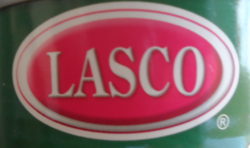


Lasco shares sell & buy FX or hold
Our response back then, thanks for your enquiry. As you will see our BUY RATED list contains these three stocks. Here are our views. First off the local stock market tends to go down around May until last June or July. This is not cast in stone, just a tendency. One reason for it is that investors get the full information as to what companies did last fiscal year and a glimpse for the new-year. In the case of the three Lasco companies they have just reported their full year results. The distributorship earning is the most encouraging of the three and looks like it will probably do better than the other three in the short to medium term. It will also benefit from the Salada Foods distribution which started this year, as well as from increased production to come from the expanded Lasco Manufacturing Company’s operation. The information suggest that the next set of results should possibly show growth over that of 2013.
Lasco Financial seems poised for good things but big marketing spend last fiscal year kept profits down as they went for more market share. It does look as if they will be spending on the world cup promotions which could build business, but may also keep profits pressured somewhat for a while.
Lasco Manufacturing seems cheap at $1 bearing in mind the impact that the factory expansion is likely to have on both sales and profits ultimately. Short term they will have to pick up interest cost and depreciation on the completed factory but will enjoy cost savings and ultimately increased profits.
It is my view that the market overall, is undervalued but investors will need to be patient and the payoff is likely to huge for those who wait, the gains to be reaped elsewhere is not likely to be all that great, to cause one to jump and possibly miss the gains in the local market that is ahead.